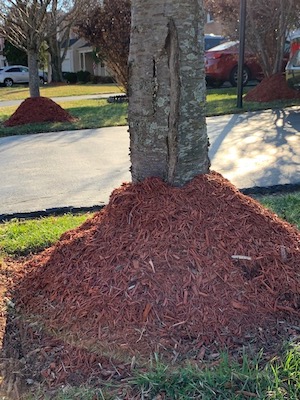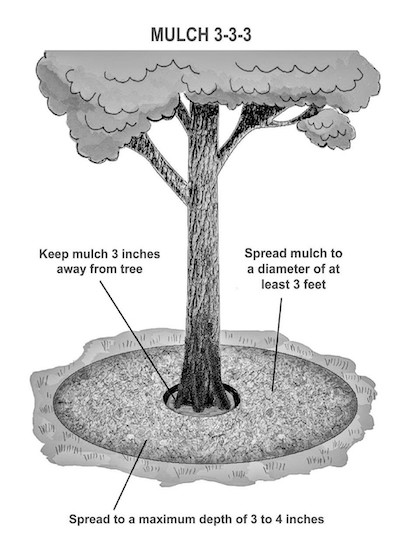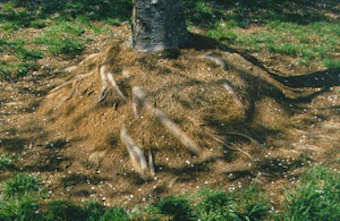Mulch — Are There Alternatives to Bark?
By Ann M. Mason, Fairfax Master Gardener Intern

Extreme example of mulch volcano
Following nature’s lead, gardeners add mulch around our planted environment: trees, shrubs, perennials, annuals, vegetables — just about anything we plant.
So, with all the benefits of mulching, what are the options? How do we choose the mulch for our location? To start, consider that all mulches have differing characteristics, advantages and disadvantages. And some mulches are better for some applications than others.
Mulches are grouped into organic, inorganic and cover crops considered as green manure. Organic mulches are from plant materials, contributing nutrients as they become part of the soil. All organic mulches need replenishment periodically as they degrade.
Bark mulch is made from byproducts of pine, cypress or hardwood logs. Aged wood chips, especially the larger chip sizes, reduce the formation of a dense, compacted layer that prevents water movement. Freshly cut wood chips form organic acids as the wood decays, which can kill or harm plants. Some trees, like black walnut (Juglans nigra), contain a chemical that inhibits growth of many plants. Sawdust is helpful in acidifying soil around acid-loving plants like rhododendrons.
Straw (not hay) is a good winter mulch for the vegetable garden, but it is flammable and may contain seeds. Pine needles (also known as pine straw) decompose slowly, resist compaction and are easy to use. Shredded leaves are free if you have trees and can use a lawn mower to break up whole leaves into smaller pieces. Grass clippings can serve as mulch. But wait three lawn mowings after an herbicide or fertilizer application prior to using clippings. Grass clippings can pack down preventing water movement unless mixed with other materials like shredded leaves.
Newspaper can effectively control weeds if placed three or four layers deep and covered with some other mulch as a weight. Shredded newspaper works well, too.
Mulch 3-3-3

Proper mulch with 3-3-3 technique
As we drive around our neighborhoods, we often see many mulch applications that are too deep. This is called ‘volcano mulching,’ named to describe the cone-shaped mulch application. Instead of helping the tree or shrub, volcano mulch can stress the tree and lead to its death. Deep mulch can suffocate tree roots and cause inner bark death. Even worse, deep mulch against a tree tricks it into sending out fibrous roots that can girdle (strangle) the tree over time. Deep mulch provides a warm, moist place for munching insects and rodents to penetrate the tree’s bark. And lastly, instead of assisting moisture retention, deep mulch can create a waterproof layer. If you have volcano mulch, pull back the mulch to the recommended 3-3-3 application.

Improper mulching causes girdling roots growing into mulch instead of the ground
Cover crops and green manures, like clover, rye or legumes, protect and enrich the soil usually in gardens planted annually. These cover crops are planted after harvest in the fall and turned over before the cover crop flowers and seeds in the spring.
Whatever type of mulch a gardener chooses, proper application and maintenance is needed to ensure the beneficial attributes are achieved. And replenishment is needed every year, or two, or three. Happy gardening.
Resources
• Selection and Use of Mulches and Landscape Fabrics., Bonnie Appleton and Kathy Kauffman, Virginia
Cooperative Extension
• Simple Guide to Plastic Mulch and Alternatives, Penn State Extension
• Mulches for the Home Vegetable Garden, D. Relf and McDaniel, Virginia Cooperative Extension
• Mulch Out, Not Up, Proper Mulching Techniques and Problems Caused by Over Mulching, Virginia
Cooperative Extension Service, Virginia Tech.
• Proper Mulching, Virginia Cooperative Extension, Loudoun County Master Gardeners
• Mulching for a Healthy Landscape, Virginia Cooperative Extension, VCE publication 426-724
• Soil Amendments, Washington State University, WSU Publication C130